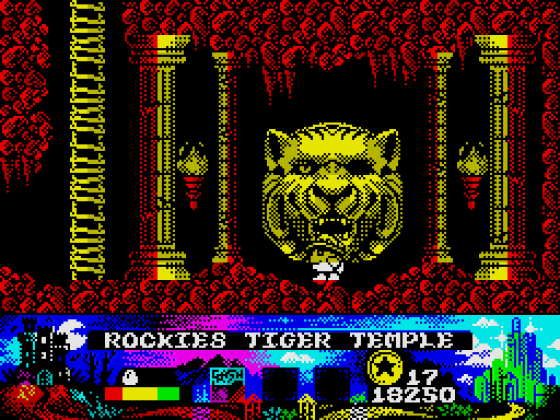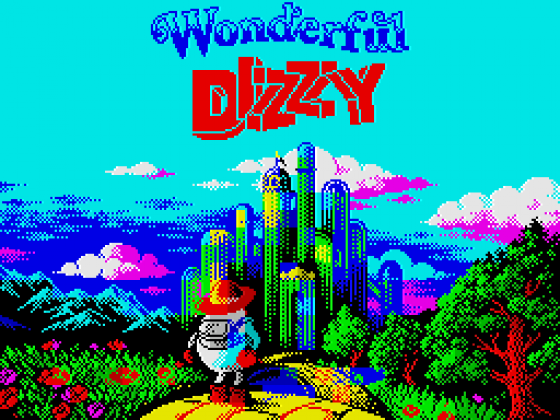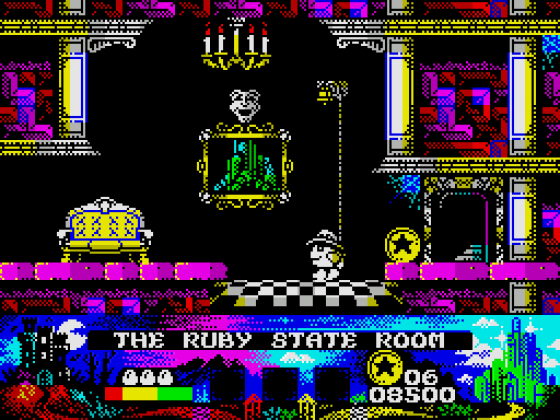
Alessandro Grussu
 9th January 2022
9th January 2022
Categories: Review: Software
Author: Alessandro Grussu
Publisher: The Oliver Twins
Machine: Spectrum 128K
Published in Al's Spectrum Annual 2021
Wonderful Dizzy
Honestly, I am not a huge fan of Dizzy games. When the first instalment of the saga appeared in the second half of 1987, I had already been a Spectrum user for three and a half years, and at the time the only game in the series I experienced was just that. Italy had since a couple of years become practically a Commodore colony, and finding Spectrum owners around, especially in an average-sized Southern city, was very difficult (not to mention the Amstrad or MSX which were almost unknown). Luckily, from the pages of Sinclair User, found by chance in May of that year in a newsstand in the city centre that sold foreign magazines, I learned of what was happening across the Channel.
The only way to get new games - apart from mail order, which was very limited anyway, unless you ordered them from British distributors, which in an era when the Web did not exist and payments were carried out through postal order was a long and complicated affair - were the (in)famous tape magazines, and it was on one of them that in September 1988 I had the opportunity to experience the first Dizzy, with the fake title of Bump!. I liked it a lot: the mix between arcade and adventure worked well, and even if it wasn't up to the level of Magic Knight games - which I still consider as the highest example of this genre on the Spectrum - it seemed quite solid, above the average of budget titles.
I became acquainted with all the other titles in the series, including arcade derivatives and official (Seymour) and unofficial clones, only almost a decade later, when I discovered Spectrum emulation on the PC. They seemed decent to me, but none impressed me that much, as they basically rehashed the first episode's basic formula, with a few new features, like the supporting cast of the Yolkfolk. For this reason, in my videogaming memories the little egg-face does not hold the same importance as other characters such as Horace, Miner Willy, Wally Week, the Atic Atac trio, Sabreman, Jetman, the Ant Attack boy and girl, Magic Knight etc.

Moreover, Dizzy has his own share of detractors; there are those who could never stand it, for one reason or another. But although I don't particularly love it, I am not among them, so that, when three years ago a group of fans created a remake of the seventh and final chapter, Crystal Kingdom Dizzy, I found it to be excellent. So did the famous Oliver Twins, authors of countless titles from the early period of Code Masters, when it dominated the market for budget 8-bit computer games. Therefore, they designed the eighth official chapter of the Dizzy saga, inspired by the Wizard of Oz story, while the same authors of the Crystal Kingdom Dizzy remake took care of its production. The end result is Dizzy 8: Wonderful Dizzy, released for free on 18 December 2020.
The story follows loosely that of The Wonderful Wizard of Oz by Frank L. Baum. Incidentally, I had to look for it on the Internet because it is not very familiar to me (it is not as popular in Italy as it is in Anglo-Saxon countries), discovering, among other things, that the book which was turned into the famous 1939 movie by Victor Fleming starring a very young Judy Garland, not yet, alas, devastated by alcohol and barbiturates, is only the first of a series including fourteen novels. Throughout the game, Dizzy and the Yolkfolk take on the roles of various characters from the book: Dorothy is played by Dizzy (with his trademark red boots taking the place of the wellknown slippers), Pogie is Toto, Denzil is the Tin Man, Daisy is the Good Witch of the North, Grand Dizzy is Tik Tok and so on.
One day, a tornado hits the hut where Dizzy lives with his pet Pogie. The hut flies up and finally lands on the mysterious land of Oz, instantly crushing the evil Witch of the East (Dizzy killing someone? Wow!). The other wicked witch, the one from the West, appears on the scene and takes Pogie away with her. From now on, Dizzy will have two concerns: finding Pogie and returning to his dimension. All the clues seem to lead to the mysterious Wizard of Oz, who lives in the Emerald Castle, beyond a field of poppies with the unpleasant characteristic of making Dizzy fall asleep forever, making him lose a life. A reference to opiate drugs, maybe? As a matter of fact, dangers do not lack: crows, snakes, flying monkeys and so on. What's worse, in all these years Dizzy has not yet learned to swim, so if he falls into water, even in a small stream, he will instantly drown. At least he finally admitted to be a kleptomaniac, when talking with Dozy/Scarecrow for the first time.

As in the other games in the series, Dizzy can carry a maximum of three items, and to use them, or give them to someone else, he must select them from a menu that appears by pressing Fire. Puzzles are not very difficult to deal with, and only in one particular case I had to refer to the story told in the book. Here too, anyway, Dizzy/Dorothy will have to take out the Witch of the West to make the Wizard of Oz, or rather he who passes himself off as such as in the novel, help him and his three friends Tin Man, Scarecrow and Cowardly Lion to solve their predicaments. Dialogues between Dizzy and the other characters also contain references to the contemporary world, which at times make Dizzy bewildered, since for the most part he appears to be stuck in the early 90s; for example, he doesn't understand what Pirate Blackbeard - who happens to live in "Pirate Bay", by the way - means when he says he can find what he needs on the "dark web". There are also coins to collect, 99 to be precise, and they will be needed right at the end of the game (actually there are 100, as the Oliver Twins themselves revealed a few days after the release; one is hidden into a secret location). Generally, they are pretty easy to find, but looking for one in particular made me scratch my head quite a bit, before the intuition that allowed me to recover it.
From a technical and above all graphic point of view, it was legitimate to expect a first-class work from the authors of the Crystal Kingdom Dizzy remake, and Wonderful Dizzy does not disappoint, far from it: settings are detailed and rich in colours, with notable differences between one part of the game world and the other, so that the player is suggested the idea of a miniature universe with its specific components, from the darkness of the forest surrounding the Western witch's castle to the magnificence of the Emerald and Ruby Castles.
Sprites move smoothly, and Dizzy responds to the player's inputs with remarkable precision, even if the usual rolling means that special attention must be paid when jumping. Sound consists of the usual effects and various pleasant tunes, heard at the beginning, during the game and at the end.
So what can be said about this new official chapter of the series, 28 years after Crystal Kingdom Dizzy? Personally, I must admit that I had not been so absorbed by the vicissitudes of the eggy character since a very long time. I played it to the conclusion with great interest and pleasure. I think we have to be grateful to everyone involved in its production for making it available to the enthusiasts' community for free.
If I have to find a defect, common to this genre of games anyway, is having to walk continuously from one location to another, even when they are very distant from each other (the so-called backtracking), to carry out the necessary tasks in order to proceed with the adventure, and the fact that a little too many times we have to turn to Rosie, the character on the bridge who speaks in rhymes, to obtain useful objects by solving her riddles, which are actually simple enough. Of course, if you loathe Dizzy, or if you just don't like arcade adventures, Wonderful Dizzy will hardly make you change your mind. For everyone else, however, it is an experience not to be missed.
Other Reviews Of Wonderful Dizzy For The Spectrum 128K
Wonderful Dizzy (The Oliver Twins/Codemasters)
A review by Dave E (Everygamegoing)
Wonderful Dizzy (The Oliver Twins)
A review by Paul Davies (Crash)















